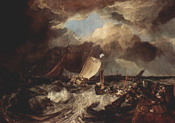| |  | J. M. W. Turner |  |
| "Light is therefore color."
*** Turner, John Mallord William (1775-1851) was an English Romantic landscape painter, watercolorist and printmaker. Turner was considered a controversial figure in his day, but is now regarded as the artist who elevated landscape painting to an eminence rivaling history painting. Although renowned for his oil paintings, Turner is also one of the greatest masters of British watercolour landscape painting. He is commonly known as "the painter of light" and his work regarded as a Romantic preface to Impressionism. |  |
Turner was born in London, England, on April 23, 1775. His father was a barber. His mother died when he was very young. The boy received little schooling. His father taught him how to read, but this was the extent of his education except for the study of art. By the age of 13 he was making drawings at home and exhibiting them in his father's shop window for sale. Turner was 15 years old when he received a rare honor: one of his paintings was exhibited at the Royal Academy. By the time he was 18 he had his own studio. Before he was 20, print sellers were eagerly buying his drawings for reproduction. He quickly achieved a fine reputation and was elected an associate of the Royal Academy. In 1802, when he was only 27, Turner became a full member. He then began traveling widely in Europe. Venice was the inspiration of some of Turner's finest work. Wherever he visited he studied the effects of sea and sky in every kind of weather. His early training had been as a topographic draftsman. With the years, however, he developed a painting technique all his own. Instead of merely recording factually what he saw, Turner translated scenes into a light-filled expression of his own romantic feelings. As he grew older Turner became an eccentric. Except for his father, with whom he lived for 30 years, he had no close friends. He allowed no one to watch him while he painted. He gave up attending the meetings of the academy. None of his acquaintances saw him for months at a time. Turner continued to travel but always alone. He still held exhibitions, but he usually refused to sell his paintings. When he was persuaded to sell one, he was dejected for days. In 1850 he exhibited for the last time. One day Turner disappeared from his house. His housekeeper, after a search of many months, found him hiding in a house in Chelsea. He had been ill for a long time. He died the following day, Dec. 19, 1851. Turner left a large fortune that he hoped would be used to support what he called "decaying artists." His collection of paintings was bequeathed to his country. At his request he was buried in St. Paul's Cathedral. Although known for his oils, Turner is regarded as one of the founders of English watercolor landscape painting. |
|
| |
|  | | "The Fighting 'Temeraire' tugged to her last berth to be broken up" (1838) Oil on canvas, 91 x 122 cm - 35.8 x 48 in. National Gallery, London, UK. | | | | |  | | "Rain, Steam and Speed" (1844) Oil on canvas, 90.8 x 121.9 cm - 35.7 x 48 in. National Gallery, London, UK. | | | | |  | | "Dido building Carthage; on the Rise of the Carthaginian Empire" (1815) Oil on canvas, 155.5 x 232 cm - 61.2 x 91.3 in. National Gallery, London, UK. | | | | |  | | "Shipwreck of the Minotaur" (1548) Oil on canvas. Calouste Gulbenkian Museum, Lisbon, Portugal. | | | | |  | | "Wreckers" (circa 1834) Oil on canvas. Yale Center for British Art, New Haven, Connecticut, USA. | | | | |  | | "Ancient Italy - Ovid Banished from Rome" (1838) Oil on canvas, 94.6 x 125 cm - 37.24 x 49.21 in. Private collection. | | | | |  | | "Calais Pier" (1803) Oil on canvas, 172.7 x 242.2 cm - 68 x 95.4 in. National Gallery, London, UK. | | | | |  | | "The Burning of the Houses of Parliament" (1835) Oil on canvas, 92.7 x 123 cm - 36.5 x 48.4 in. Cleveland Museum of Art, Ohio, USA. | | | | |  | | "The Grand Canal - Venice" Oil on canvas, 91 × 122 cm - 35.8 × 48 in. Metropolitan Museum of Art, New York City, N.Y., USA. | | | | |  | | "Sunrise with Sea Monsters" (1845) Oil on canvas. | | | | |  | | "The Slave Ship" (1840) Oil on canvas, 90.8 x 122.6 cm - 35.7 x 48.3 in. Museum of Fine Arts, Boston, Massachusetts, USA. | | | | |  | | "Shade and Darkness - the Evening of the Deluge" (exhibited 1843) Oil on canvas, 78.7 x 78.1 cm - 31 x 30.7 in. Stolen on July 28, 1994 from Kunsthalle Schirn, Frankfurt am Main, Germany. |
|
Text source: 'Wikipedia' (www.wikipedia.org) and others. | |
|
|